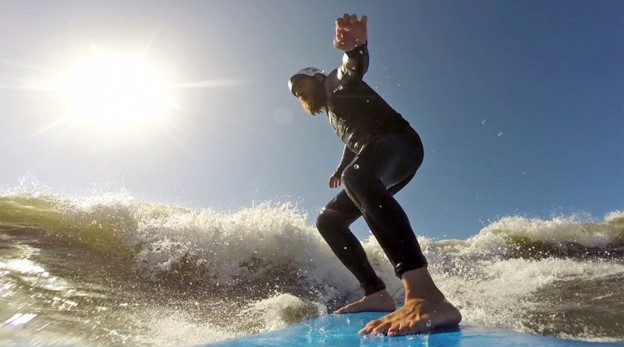Blind Surfer Rides the Waves of Life

by Sierra Romero
Surfing commands precision, endurance, patience, and so much more. Every second and every movement counts. According to a 2018 study by Ponting and O’Brien, there are around 35 million surfers in at least 162 countries worldwide. As the number continues to increase every day, there is also a growing demographic of surfers who take on an additional challenge beyond commanding the waves.
Joshua Loya, 39, is a blind national championship surfer from Santa Cruz, Calif. In his sophomore year of high school, Loya went blind as the result of an accident, but he didn’t let it stop him from experiencing all that life has to offer. In 2003, Loya moved to San Diego and began to push himself to try new and exhilarating activities, including skydiving, water skiing, and martial arts.
He quit his job in 2016 as an assistant technology trainer to pursue martial arts and adventure living full-time. He came across a local organization called the Swami Surf Association, which is dedicated to providing an opportunity for people who are blind or visually impaired to try out surfing in a safe and fun environment. Loya found the sport so fun that he decided he wanted to continue surfing. He found that a multitude of skills and techniques he used from his martial arts training transferred well into surfing, including balancing and being able to quickly jump to your feet on the board.
As Loya continued to practice and improve, others began to notice his potential. Pat Weber, a coach from the San Diego Surfing Academy, approached Joshua to offer his contact information if he ever wanted to get into adaptive competitions. Since Loya’s love for the newfound sport kept growing, and with the U.S Open of Adaptive Surfing Competition less than two months away, the two began working together.
Loya came in third place in his first-ever competition, an incredible feat, but it didn’t stop there. In June 2018, in only his second competition, Loya took first place and made the USA National Adaptive Surf Team. Following that, Loya was able to travel to Hawaii where he came in second overall at the Duke’s OceanFest Access Surf Hawaii event.
Surfing requires a combination of technique, balance, and practice. It’s a demanding sport and can seem intimidating, especially to someone who is blind or visually impaired. However, there are a variety of different tools and strategies used to make surfing adaptive for anyone with a visual impairment. Many surfers have a guide in the water near them who calls out waves or helps line up the board with clockwork directions or angle measurements. During a competition, each surfer is allowed to have a guide in the water for 20 minutes. The guide can communicate vocally with the surfer but is not allowed to make any physical contact. There is also a whistle signaling system that is used among surfers and guides, where the number of whistles indicates the direction of the wave.
Loya has found surfing as a way to experience nature in an unfiltered way. He explains there are a lot of people who are always trying to protect people who are blind or visually impaired from the world because of their eyesight. “But in the water, it’s just you and the wave and you have to think about this present moment,” says Loya. There is an individual connection that is made between the surfer and nature, and all else fades away. There’s a sense of independence, and accomplishment that comes with this. “Surfing can be really challenging, but being able to do something that’s a challenge, that’s cool,” he adds.
Surfing was voted to the Olympic program in 2016 and will make its first appearance in this summer’s Tokyo Games. The International Surfing Association is now pushing for surfing to become an adaptive Paralympic sport in the coming years, hopefully by 2024 or 2028. There are still questions in terms of how to determine the classification of different divisions to maintain fairness.
Loya found surfing by accident, a random urge to try something new and out of his comfort zone. Now he is involved in a sport that he loves and finds therapeutic, rewarding, and inspiring.
For anyone else out there who wants to begin surfing but is intimidated or unsure of where to start, Loya advises to look locally for individuals or organizations already participating in the sport. If there are none around, looking for someone willing to get in the water, stay near, and begin calling out waves is sufficient for the beginning. The first step, after all, is to get into the water.

Snapshot of Joshua Loya smiling, paddling on a surfboard. (photo by San Diego Surfing Academy)
